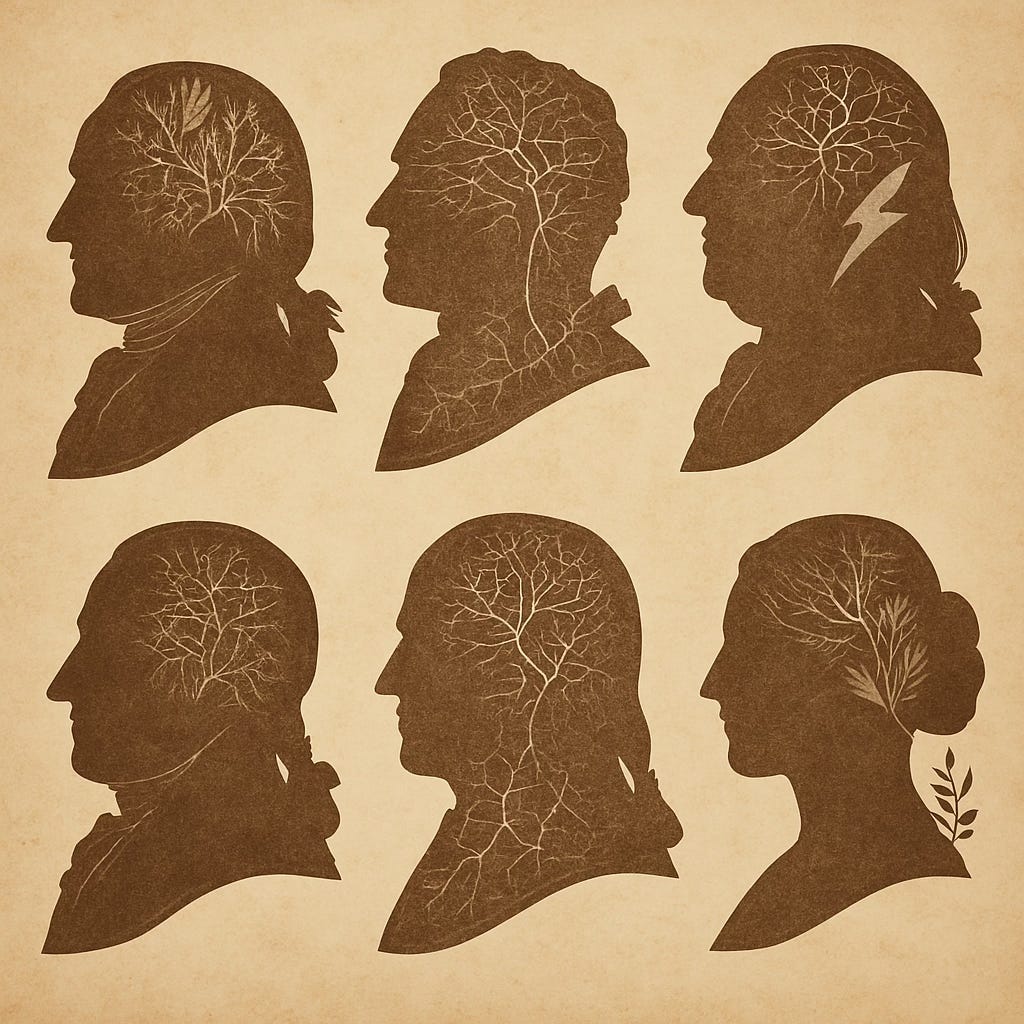The Neurodivergent Design of a Nation: A THX Reflection on the Founders
From the THX Series Hub: Neurodivergence & the Founding of a Nation
"The sacred rights of mankind are not to be rummaged for among old parchments or musty records. They are written, as with a sunbeam... by the hand of divinity itself." — Alexander Hamilton
What if the lasting strength of the American founding wasn’t the result of like-minded unity—but of structured cognitive dissonance? What if the true genius of the Revolution wasn’t just in its ideals—but in how different types of minds were allowed to shape it?
From the earliest days of the republic, the Founders didn’t operate as a consensus machine. They were a dynamic, often volatile, constellation of thinkers: each with distinct temperaments, emotional wiring, mental habits, and value systems. And yet, their interplay—and the tension it created—was exactly what made the American experiment work.
When we apply the THX frameworks (12 Utilities → PERMAH → Admiration Equation), we begin to see that the Founders didn’t just build a system of government—they modeled a system of transformation. Together, they formed an ecosystem of cognitive and emotional difference that produced balance through disagreement.
A System of Minds in Balance
Jefferson, the visionary, drafted ideals as architecture. He wrote with clarity and abstraction, crafting a language of liberty that would echo for centuries.
Hamilton, all energy and momentum, turned theory into institution with breathtaking speed. He wrote 51 Federalist Papers in six months, managed economic crises, and insisted on a strong central government.
Adams, resolute and principled, resisted mob thinking. His unpopular defense of British soldiers after the Boston Massacre was an early sign of his devotion to law over popularity.
Franklin bridged science and society with joy. He founded civic institutions, wrote satirical essays, and used humor to translate Enlightenment thinking into daily life.
Washington didn’t theorize—he embodied. His restraint after the war and refusal of a third term weren’t just acts of humility—they were essential signals that power in America could be temporary.
Madison structured the system itself. His Constitution was a nervous system built to absorb disruption through design.
Abigail Adams, operating from the margins, infused the founding with emotional foresight. Her letters to John warned of hypocrisy: "Remember the ladies," she wrote, "or we too will foment a rebellion."
Each of them brought different THX Utilities into play. Hamilton offered Speed and Closure. Madison, Accuracy and Consistency. Franklin made Emotion Evoked usable. Washington optimized for Security. Together, they activated different forms of PERMAH—from Jefferson’s Meaning and Achievement to Abigail’s Relationships and Positive Emotion.
Conflict as Catalyst
History remembers the disagreements between Jefferson and Hamilton. But what if that tension was the feature—not the flaw?
Jefferson envisioned an agrarian republic grounded in local autonomy. Hamilton pushed for urban manufacturing and centralized banking. Their debates weren’t petty—they were design constraints. Jefferson feared tyranny. Hamilton feared weakness. Their competing biases helped create a government that was neither anarchic nor authoritarian.
Adams, deeply mistrustful of populism, advocated for strong institutions and was horrified by Jefferson's flirtation with the French Revolution’s chaos. Meanwhile, Franklin navigated both men with humor and reason, offering human connection where ideology failed.
And in the background, Washington held the center. His refusal to overstep, to speak too often in the Constitutional Convention, or to remain in power too long became the unspoken scaffolding for American democratic norms.
THX in Motion
The Founders didn’t just fill out PERMAH individually. They balanced it collectively:
Jefferson’s Meaning needed Adams’s Achievement to hold moral weight.
Hamilton’s Engagement needed Washington’s Security to be trusted.
Franklin’s Positive Emotion helped temper the rigid logic of Madison’s Consistency.
Abigail’s Relationships gave humanity to the otherwise intellectual revolution.
Even in their failings, we learn from how they tried. They argued through letters. They planted seeds in each other’s thinking. They didn’t always listen—but they didn’t silence each other either.
From Tension to Admiration
Their legacy lives in the Admiration Equation not because they were perfect—but because they mattered. Each brought Skill in wildly different ways. Each displayed Goodness within their frame of values. Each inspired Awe in their intellectual or emotional reach. And each earned Gratitude—not always in their lifetime, but certainly over time.
We don’t admire them because they always got it right. We admire them because they created something bigger than themselves.
What This Means for Us
The Founders didn’t win through charisma or homogeneity. They succeeded because they designed a system where different kinds of minds could shape, check, and challenge each other.
They modeled a leadership culture where intensity was balanced by reflection, where emotional insight mattered as much as strategic brilliance, and where disagreement was baked into the architecture of liberty.
Today, as we navigate polarized landscapes and complex challenges, their example reminds us: the goal isn’t uniformity. It’s resonant difference. Aligned purpose, divergent wiring.
Because transformation doesn’t come from a single mind—it comes from a system of minds, allowed to work in balance.
What kind of mind do you bring to the systems you're part of? And what kind of minds are missing?
Let’s keep building.
A series from Transform the Human Experience (THX). Explore the individual founder essays and frameworks: THX Utilities → PERMAH → Admiration Equation.

Interpretation:
This image represents the Founders not as static icons but as dynamic minds—each contributing a unique way of thinking, feeling, and building. The variety of neural textures within each silhouette honors their differences, while their shared background and collective orientation signal harmony through contrast. It’s not unity in sameness, but transformation through structured difference.



